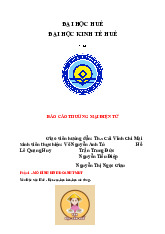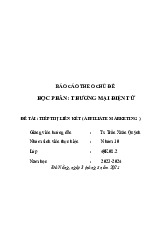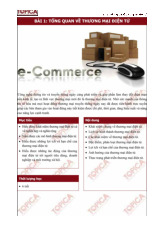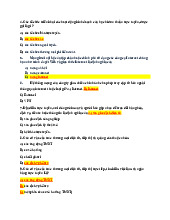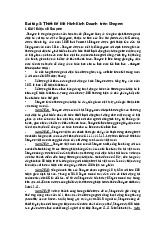



















Preview text:
lOMoAR cPSD| 58797173
Câu hỏi ôn thi Thương mại điện tử ( E- commerce) Chap 1:
1. E-commerce can be defined as:
➢ The use of the Internet, the Web, and mobile apps to transact business.
2. Which of the following is an example of e-business?
➢ Amazon's inventory control system B.
3. Which of the following can be considered synonymous with the term ecommerce? ➢ Digital commerce.
4. The term e-commerce refers to the digital enabling of business
processesboth inside and outside the firm. ➢ FALSE.
5. E-commerce and e-business systems blur together at the business
firmboundary, where internal business systems link up with suppliers or customers. ➢ TRUE.
6. Which of the following is not a unique feature of e-commerce technology? ➢ Information asymmetry.
7. Which of the following features of e-commerce technology enables lOMoAR cPSD| 58797173
merchants to market and sell "complex" goods and services to
consumers via marketing messages that can integrate video, audio, and text? ➢ Richness.
8. Which of the following features of e-commerce technology allows users
toparticipate in the creation of online content? ➢ Social technology.
9. Which of the following is the best definition of transaction cost?
➢ the cost of participating in a market.
10.Which of the following features of e-commerce technology is
related to the concept of network externalities? ➢ Universal standards.
11.Which of the following statements is true about the traditional tradeoff
between the richness and reach of a marketing message prior to the development of the Web?
➢ The larger the audience reached, the less rich the message.
12.Interactivity in the context of e-commerce provides which of the following functionalities?
➢ Enabling two-way communication between consumer and merchant. lOMoAR cPSD| 58797173
13.The costs incurred by merchants in having to change product prices (such
as the costs of reentering prices into computer systems) are referred to as which of the following? ➢ Menu costs.
14.Which of the following refers to any disparity in relevant market
information among parties in a transaction? ➢ information asymmetry.
15.Which of the following is a physical place you visit in order to transact? ➢ Marketplace.
16.The total number of users or customers an e-commerce business can
obtain is a measure of which of the following? ➢ Reach.
17.Which of the following refers to the complexity and content of a message? ➢ Richness.
18.E-commerce is available just about everywhere and anytime. This is known as: ➢ Unbiquity.
19.Ubiquity lowers the cognitive energy required to transact in a marketspace. ➢ TRUE.
20.The fact that e-commerce is conducted based on universal standards
decreases search costs for consumers. lOMoAR cPSD| 58797173 ➢ TRUE.
21.Universal standards make price discovery more costly, slower, and less accurate ➢ FALSE.
22.Price transparency refers to the ease with which consumers can find out
what merchants pay for products. ➢ FALSE.
23.Personalization involves targeting marketing messages to specific
individuals by adjusting the message based upon a consumer's
preferences or past purchasing behavior. ➢ TRUE.
24.E-commerce technologies provide a unique, many-to-many model of mass communication. Answer: ➢ TRUE.
25.Which type of e-commerce is distinguished by the type of technology
used in the transaction rather than by the nature of the market relationship? ➢ mobile e-commerce.
26.Which of the following is an example of social e-commerce? ➢ Facebook.
27.Business-to-consumer (B2C) e-commerce in the United States: lOMoAR cPSD| 58797173
➢ has grown at double-digit rates between 2010 and 2017.
28.Which of the following is not true about the use of apps?
➢ Users still spend less time using apps than they do using desktops or mobile websites. lOMoAR cPSD| 58797173
29.Which of the following is an example of an on-demand service company? ➢ Airbnb
30.Which of the following is an example of B2B e-commerce? ➢ Go2Paper
31.Which of the following is an example of C2C e-commerce? ➢ Craigslist
32.All of the following are examples of social networks except: ➢ Y Combinator.
33.B2B e-commerce is the largest type of e-commerce. ➢ TRUE.
34.Which of the following is not a major business trend in e-commerce in 2017-2018?
➢ Small businesses and entrepreneurs are hampered by the rising cost
of market entry caused by increased presence of industry giants.
35.All of the following are major social trends in e-commerce in 2017-2018 except for:
➢ participation of adults in social networks begins to decrease.
36.Which of the following statements about the mobile platform is not true?
➢ The time U.S. adults spend using mobile apps accounts for over 60%
of total digital minutes spent. lOMoAR cPSD| 58797173
37.Which of the following describes the basic web policy of large firms during the Invention period?
➢ Maintain a basic, static website depicting the firm's brand.
38.It is estimated that by 2021, the size of the B2B market will reach: ➢ $7.6 trillion.
39.Which of the following statements about the Web is not true?
➢ The Web is the technology upon which the Internet is based.
40.In 2017, there were more than Internet hosts. ➢ 1 million
41.All of the following can be considered a precursor to e-commerce except:
➢ the development of the smartphone.
42. was the first truly large-scale digitally enabled transaction system in the B2C arena. ➢ The French Minitel
43.In which year can e-commerce be said to have begun? ➢ 1995
44.All of the following are issues facing Pinterest except: ➢ scams. lOMoAR cPSD| 58797173
45.Which of the following is a characteristic of e-commerce during the Invention period? ➢ disintermediation
46.All of the following are examples of Web 2.0 sites and applications except: ➢ auction sites.
47.Which of the following is not a characteristic of a perfect competitive market? ➢ It is highly regulated.
48.All of the following were visions of e-commerce expressed during the early years of e- commerce except: ➢ fast follower advantage.
49.Unfair competitive advantages occur when:
➢ one competitor has an advantage others cannot purchase.
50.The early years of e-commerce were driven by all of the following factors except:
➢ an emphasis on exploiting traditional distribution channels.
51.The early years of e-commerce are considered:
➢ a stunning technological success as the Internet and the Web
increased from a few thousand to billions of ecommerce transactions per year.
52.Which of the following best describes the early years of e-commerce?
➢ They were a technological success but a mixed business success. lOMoAR cPSD| 58797173
53.Which of the following is a characteristic of the Reinvention phase of ecommerce?
➢ expansion of e-commerce to include services as well as goods
54.Which of the following is a characteristic of the Consolidation phase of ecommerce?
➢ brand extension and strengthening becomes more important than creating new brands
55.Which of the following is not true regarding e-commerce today?
➢ The market middlemen disappeared.
56.Which of the following statements is not true?
➢ Overall transaction costs have dropped dramatically.
57.Which of the following is an example of an e-commerce first mover that failed? ➢ eToys
58.Which of the following refers to the practice of researching a product
online before purchasing it at a physical store? ➢ webrooming
59.Which of the following was the original "killer app" that made the
Internet commercially interesting and extraordinarily popular? ➢ The Web lOMoAR cPSD| 58797173
60.Which of the following refers to the displacement of market middlemen
and the creation of a new direct relationship between producers and consumers? ➢ disintermediation
61.Which of the following is not an element of friction-free commerce?
➢ Transaction costs are high.
62.Retail e-commerce in the United States is not expected to continue growing
at double-digit growth rates in 2017-2018. ➢ FALSE
63.The Internet is a worldwide system of computer networks. ➢ FALSE
64.The Internet has shown similar growth patterns as other electronic
technologies of the past. Answer: ➢ FALSE
65.The emergence of mobile, social, and local e-commerce occurred during
the the Reinvention period of e- commerce. ➢ FALSE
66.The Reinvention period of e-commerce is as much a sociological
phenomenon as it is a technological or business phenomenon. ➢ TRUE
67.Price dispersion has been eliminated in e-commerce ➢ FALSE 68.Above all, e-commerce is a phenomenon. lOMoAR cPSD| 58797173 ➢ technology driven.
69.Which business application is associated with the technological
development of local area networks and client/server computing?
➢ workgroup automation (e.g., document sharing)
70.Which of the following is one of the three primary societal issues related to e-commerce? ➢ intellectual property Chap 2:
1. and are typically the most easily identifiable aspects of a company's business model. lOMoAR cPSD| 58797173
➢ Value proposition; revenue model
2. All of the following are using a subscription revenue model for music except: ➢ Scribd.
3. Which element of the business model addresses what a firm provides that otherfirms do not and cannot? lOMoAR cPSD| 58797173 ➢ value proposition
4. Which element of the business model refers to the presence of substitute products in the market? ➢ competitive environment
5. Which of the following are Amazon's primary value propositions? ➢ selection and convenience
6. A firm's describes how a firm will produce a superior return on invested capital. ➢ revenue model
7. Which of the following is an example of the subscription revenue model? ➢ eHarmony
8. Stickiness is an important attribute for which of the following revenue models? ➢ advertising revenue model
9. Which of the following companies uses a transaction fee revenue model? ➢ E*Trade
10.Which of the following is an example of the affiliate revenue model? ➢ MyPoints
11.Which of the following involves a company giving away a certain level of
product or services without charge, but then charging a fee for premium levels of the product or service? ➢ freemium strategy
12.Which of the following factors is not a significant influence on a company's competitive environment? lOMoAR cPSD| 58797173
the availability of supportive organizational structures
13.Which of the following would be considered an indirect competitor of Priceline? ➢ Expedia
14.The existence of a large number of competitors in any one market segment may indicate: ➢ the market is saturated.
15.All of the following can be considered a direct or indirect competitor of mazon except: ➢ Starbucks.
16.A perfect market is one in which:
➢ there are no competitive advantages or asymmetries because all firms have
equal access to all the factors to production.
17.Organizations that typically provide an array of services to start-up companies
along with a small amount of funding are referred to as: ➢ incubators.
18.A specifically details how you plan to find customers and to sell your product. ➢ market strategy
19.Which of the following is not a community provider? ➢ Priceline
20.Which of the following is not a variation of the e-tailer business model? ➢ market creator lOMoAR cPSD| 58797173
21.An example of a company using the content provider model is: Rhapsody.
22.Which of the following is not an example of the bricks-and-clicks e-tailing business model? ➢ Bluefly
23.The overall retail market in the United States in 2015 was estimated at about: ➢ $4.8 trillion.
24.In general, the key to becoming a successful content provider is to:
➢ provide online content for free.
25.Which of the following was not able to successfully implement a freemium business model? ➢ Pandora
26.All of the following may lead to a competitive advantage except: ➢ fewer products.
27.Which of the following is an unfair competitive advantage? ➢ brand name
28.Which of the following gives a business model the most credibility with outside investors?
➢ the firm's management team
29.Which of the following statements about Foursquare is not true?
➢ Foursquare combines a social network business model with location-based technology. lOMoAR cPSD| 58797173
30.Which type of investor typically becomes interested in a start-up company
after it has begun generating revenue? venture capital investors lOMoAR cPSD| 58797173
31.Which of the following is another name for a revenue model? ➢ financial model
32.All of the following use a social network marketing strategy except: ➢ Amazon.
33.The use by a company of its competitive advantage to achieve more advantage
in surrounding markets is known as . ➢ leverage
34.A wealthy individual who invests personal funds in a start-up in exchange for
an equity stock in the business is referred to as a(n) . ➢ angel investor
35.Which of the following is not a key element of an elevator pitch? ➢ legal structure
36.A value proposition defines how a company's product or service fulfills the needs of a customer. ➢ TRUE
37.Firms that fail to produce returns greater than alternative investments typically go out of business. ➢ TRUE
38.An asymmetry exists whenever all participants in a market have equivalent resources. ➢ FALSE
39.First movers are often not as successful as follower firms. ➢ FALSE lOMoAR cPSD| 58797173
40.All firms need an organization to efficiently implement their business plans and strategies ➢ FALSE
41.The JOBS Act and issuance of enabling regulations by the Securities and
Exchange Commission allows a start-up company to use crowdfunding to
solicit accredited investors to invest in small and early-stage start-ups. ➢ TRUE
42.The business model of e-tailers is quite similar to that of: ➢ e-distributors.
43.All of the following use an advertising revenue model except: ➢ Amazon.
44.Which of the following is not considered a portal? ➢ Amazon
45.Portals primarily generate revenue in all of the following ways except: ➢ sales of goods.
46.The basic value proposition of community providers is:
➢ they offer a fast, convenient one-stop site where users can focus on their
most important concerns and interests.
47.eBay uses all of the following business models except: ➢ content provider.
48.All of the following are business models employed in the ➢ peer-to-peer streaming. lOMoAR cPSD| 58797173
49.The financial services, travel services, and job placement services industries
typically use the business model. ➢ transaction broker
50.In the business model, a Web-based business builds a digital
environment in which buyers and sellers can meet, display products, search for
products, and establish prices. ➢ market creator
51.On-demand service companies are characterized by the free sharing of
resources between the company and consumers. ➢ FALSE
52.All of the following are examples of business-to-business (B2B) business models except: ➢ e-tailers.
53.What is the primary revenue model for an e-distributor? ➢ sales
54.W.W. Grainger is an example of which of the following business models? ➢ B2B service provider
55. create and sell access to digital markets. ➢ E-procurement firms
56.Which of the following may offer its customer’s value chain management software? ➢ e-procurement companies
57.Over the past decade, the number of exchanges has: lOMoAR cPSD| 58797173 ➢ diminished sharply.
58.SupplyOn is an example of a(n): ➢ industry consortium.
59.A marketplace supplies products and services of interest to particular industries. ➢ vertical
60.SaaS and PaaS providers can typically provide services at lower costs through scale economies. ➢ TRUE
61.Which business strategy involves implementing a new, more efficient set of
business processes that other firms cannot yet obtain?
➢ strategy of cost competition
62.Which of the following features of e-commerce technology changes industry
structure by lowering barriers to entry but greatly expands the market at the same time? ➢ global reach
63.Which of the following is not a primary activity in a firm value chain? ➢ finance/accounting
64.A is a networked business ecosystem that coordinates a firm's
suppliers, distributors, and delivery firms with its own production needs using
an Internet-based supply chain management system. ➢ value web
